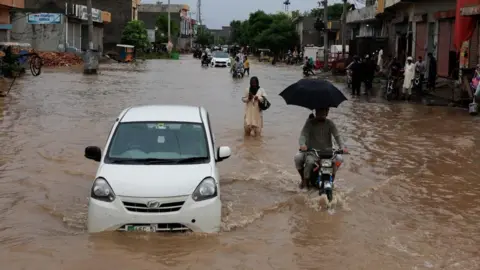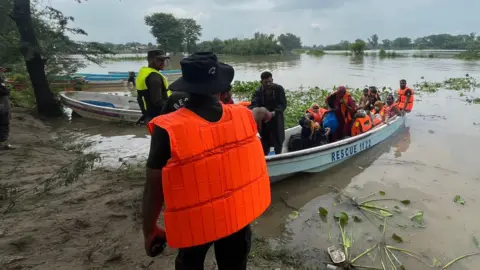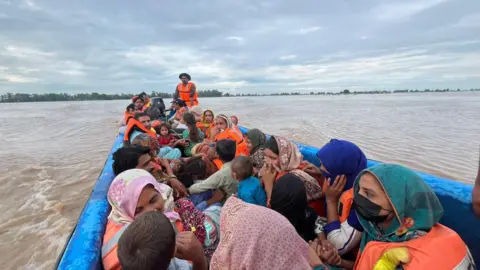Pakistan correspondent, in Sialkot
BBC News, in London
Some 200,000 people have been evacuated as floods devastate parts of Pakistan’s Punjab province.
Rescuers carried residents to safety in boats after disaster authorities warned of “exceptionally high” floods along the Ravi, Sutlej and Chenab rivers. Several districts called in the army to help.
It comes after Pakistani officials said India had warned it would release water from major dams upstream, acknowledging this would flood parts of what is Pakistan’s most populous province.
Both countries have suffered intense rainfall in recent weeks, with monsoon rains killing more than 800 people in Pakistan since June.
The country’s National Disaster Management Authority (NDMA) has warned people in affected areas to stay away from rivers, drains and low-lying zones.
Prime Minister Shehbaz Sharif said the federal government would fully co-operate with regional authorities to avert the risk of flooding, particularly in the urban areas of Gujarat, Sialkot, and Lahore – Pakistan’s second-most populous city.
Sialkot has seen more rainfall in 24 hours than the highest record in the past 49 years, according to Pakistan’s chief meteorologists. This has left cars, homes and buildings submerged.
Many of the city’s residents are stranded, the federal planning minister has told the BBC.
 Reuters
ReutersRescuers have been going door-to-door in villages, relocating residents and their livestock by boat.
These boats have saved more than 32,000 people who were trapped by floodwater, the Reuters news agency reports, citing local officials.
The BBC travelled alongside rescuers as they evacuated hundreds of people from one village in Kasur district, on the border with India.
The Sutlej River had overflowed, submerging homes and washing away the walls that were meant to protect them.
One resident, Nadeem Ahmad, told us he was refusing to leave.
He has been through multiple evacuations over the years and has said his family simply can’t afford to leave once again.
He showed us the dozens of cows he keeps near his home, and the hay he stores to feed them. “I’m already using their winter supply,” he said.
Others have accepted help from emergency teams, choosing to stay in shelters or with friends and relatives who live on higher ground.
We joined more than 20 men, women and children who had huddled together on a small boat. One woman cradled her two-month-old child on her lap as the boat sped through brown currents.
 Azadeh Moshiri/BBC
Azadeh Moshiri/BBC Azadeh Moshiri/BBC
Azadeh Moshiri/BBCThese floods are ruinous to many families in a country where more than 40% of people live below the poverty line.
That is why many people the BBC has spoken to in the past two days have said they are refusing to evacuate.
They would rather take their chances – protecting as much of their property and their belongings as they can – even if that means risking their lives.
Around half the residents of a village we visited, a community of about 3,000 people located two hours from Lahore, were refusing to evacuate.
According to disaster authorities in Pakistan, Wednesday’s flooding follows a warning from India that it would release water from major upstream dams.
When India’s reservoirs are overwhelmed, the release of water can cause heavy flooding downstream – which is happening across swathes of Pakistan’s Punjab, officials say.
India’s warning was a rare moment of public diplomacy between the two countries, which went through their most significant military conflict in decades in May.
Both have both been ravaged by floods after extreme monsoon rains.
On Tuesday a landslide on the route to the popular Hindu shrine Vaishno Devi killed at least 30 people in Indian-administered Kashmir, officials said.





